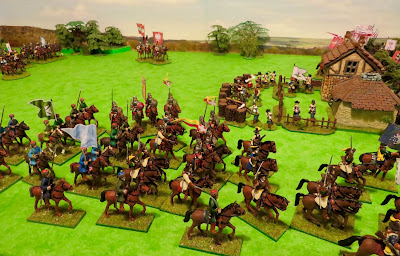I've been reading some of the information on Wikipedia about the Polish-Swedish war of 1626-9. One battle that I thought I could use as a basis for a scenario was the battle of Trzciana (see https://en.wikipedia.org/wiki/Battle_of_Trzciana).
Scenario
A Swedonian force has invaded Polonia, their rearguard has setup a position in and around a village. The Polonians assisted by troops sent by Wittenberg are following the Swedonian army and will attack the rearguard in force. Troops from the main body of the Swedonian army are led back to assist with the withdrawal of the rearguard
Objective: Swedonians to extricate the rearguard - saving the guns & dragoons and not incurring more than 15% casualties.
Table layout. (approx 7ft by 4ft):
Forces:
Swedonia
The Rearguard: S1 & S2 - Two brigades of cavalry (a total of 4 units); S3 - 2 model guns/crew and a half unit of Dragoons. Reinforcements from Main Body:
- SR1 - 2 units of cavalry; arrive on table move 10
- SR2 - 2 units of elite cavalry led by the King of Swedonia; arrive on table move 7.
- PC1 - 2 units of Light cavalry/cossacks
- PC2 - 1 unit Winged Hussars, 2 Units of Pancerni; arrive on table move 5
- Wittenberg Allied cavalry - 3 units of horse, 1 unit of cuirassier; arrive on table move 8.
Game Report:
The Swedonian rearguard in position in and around the village ....
The Polonian light cavalry deploy in front of the woods.....
A brigade of Swedonian cavalry engages the Polonian light cavalry....
The commander of dragoons sees something ....
More Polonian cavalry come into sight, led by winged hussars ....
A unit of pancerni attack the flank and rear of the Swedonian cavalry ......
The Winged hussars with a unit of pancerni in support skirt round the village ....
they line up ready to charge the other brigade of Swedonian cavalry ....
The King of Swedonia arrives with two units of elite cavalry .....
The first brigade of Swedonian cavalry is in trouble .......
As they break and rout followed by the Polonian light cavalry and pancerni, the Wittenberg cavalry has arrived and forms ups.....
the routing Swedonians pass by the village ....
The other brigade of the Swedonian rearguard has just held the charge of the Polonian winged hussars ...
The King of Swedonia forms up his brigade as another brigade arrives
He then leads the charge forward to hold off the Polonian cavalry to his front ....
The Polonian winged hussars have broken the Swedonian rearguard brigade and carry on into the Swedonian reinforcements.....
While they get the chance, most of the Swedonian dragoons mount up and make a hasty withdrawal from the village....
the Swedonian re-inforcements beat the tired Polonian winged hussars who fall back to re-group enabling the Swedonians to withdraw....
The King of Swedonia's elite cavalry beat their opposition who fall back to re-group as well. The King's brigade also start their withdrawal.
A victory for Polonia ...
---oxo---
Approximate Polonian losses - 10% of their cavalry.
A victory for Polonia, the Polonians have dislodged the rearguard but not destroyed it - once they re-group they can continue the pursuit; The Swedonians have lost their artillery and the rearguard cavalry is in on the run being covered by the King with the cavalry from the main body.




















2 comments:
This is a marvelous battle report! The use of my favorite historical cavalry unit, the Polsh (Polonian) winged hussars definitely was eye catching. The Poles also used regiments of pistoleers from Germany as mercenaries. Will the Polonians do battle with the Begovians?
Polonia V Begovia, certainly an option. Will probably have to adjust the current 18C army composition for the Begovians to suit an earlier date.
Post a Comment